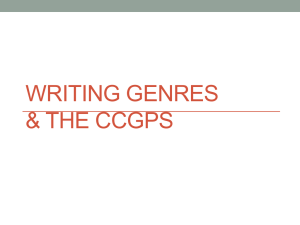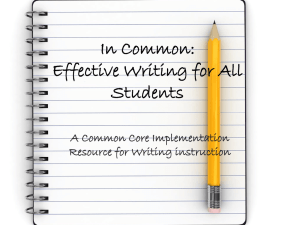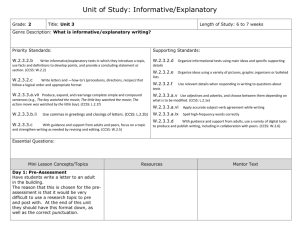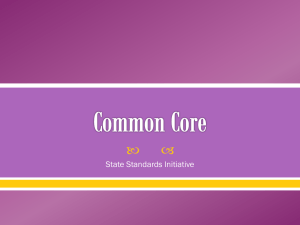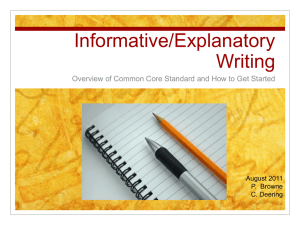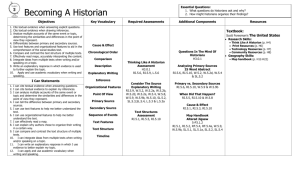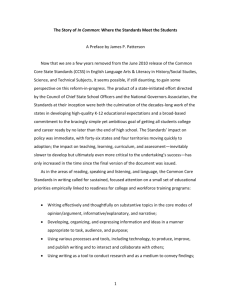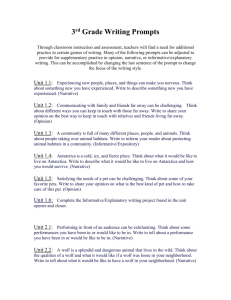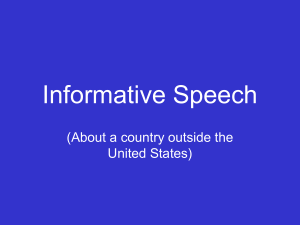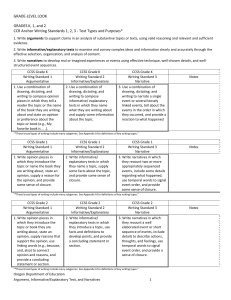Greater Independence Behavioral Objectives
advertisement
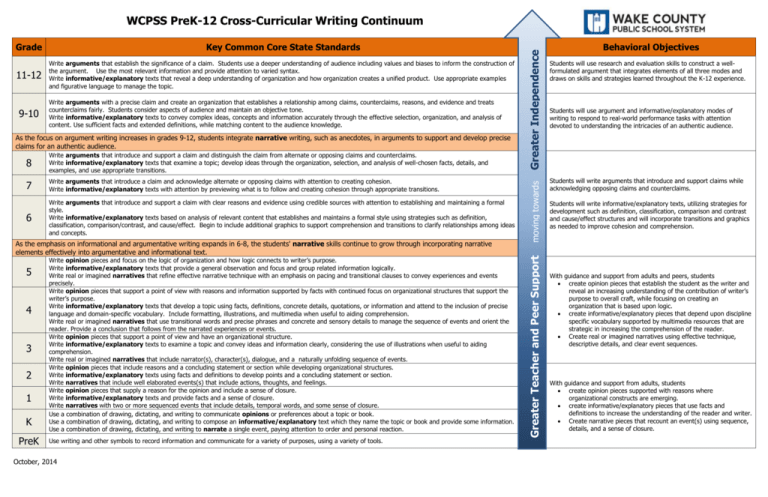
11-12 Write arguments that establish the significance of a claim. Students use a deeper understanding of audience including values and biases to inform the construction of the argument. Use the most relevant information and provide attention to varied syntax. Write informative/explanatory texts that reveal a deep understanding of organization and how organization creates a unified product. Use appropriate examples and figurative language to manage the topic. 9-10 Write arguments with a precise claim and create an organization that establishes a relationship among claims, counterclaims, reasons, and evidence and treats counterclaims fairly. Students consider aspects of audience and maintain an objective tone. Write informative/explanatory texts to convey complex ideas, concepts and information accurately through the effective selection, organization, and analysis of content. Use sufficient facts and extended definitions, while matching content to the audience knowledge. As the focus on argument writing increases in grades 9-12, students integrate narrative writing, such as anecdotes, in arguments to support and develop precise claims for an authentic audience. 8 Write arguments that introduce and support a claim and distinguish the claim from alternate or opposing claims and counterclaims. Write informative/explanatory texts that examine a topic; develop ideas through the organization, selection, and analysis of well-chosen facts, details, and examples, and use appropriate transitions. 7 Write arguments that introduce a claim and acknowledge alternate or opposing claims with attention to creating cohesion. Write informative/explanatory texts with attention by previewing what is to follow and creating cohesion through appropriate transitions. 6 Write arguments that introduce and support a claim with clear reasons and evidence using credible sources with attention to establishing and maintaining a formal style. Write informative/explanatory texts based on analysis of relevant content that establishes and maintains a formal style using strategies such as definition, classification, comparison/contrast, and cause/effect. Begin to include additional graphics to support comprehension and transitions to clarify relationships among ideas and concepts. As the emphasis on informational and argumentative writing expands in 6-8, the students' narrative skills continue to grow through incorporating narrative elements effectively into argumentative and informational text. 5 4 3 2 1 K PreK Write opinion pieces and focus on the logic of organization and how logic connects to writer’s purpose. Write informative/explanatory texts that provide a general observation and focus and group related information logically. Write real or imagined narratives that refine effective narrative technique with an emphasis on pacing and transitional clauses to convey experiences and events precisely. Write opinion pieces that support a point of view with reasons and information supported by facts with continued focus on organizational structures that support the writer’s purpose. Write informative/explanatory texts that develop a topic using facts, definitions, concrete details, quotations, or information and attend to the inclusion of precise language and domain-specific vocabulary. Include formatting, illustrations, and multimedia when useful to aiding comprehension. Write real or imagined narratives that use transitional words and precise phrases and concrete and sensory details to manage the sequence of events and orient the reader. Provide a conclusion that follows from the narrated experiences or events. Write opinion pieces that support a point of view and have an organizational structure. Write informative/explanatory texts to examine a topic and convey ideas and information clearly, considering the use of illustrations when useful to aiding comprehension. Write real or imagined narratives that include narrator(s), character(s), dialogue, and a naturally unfolding sequence of events. Write opinion pieces that include reasons and a concluding statement or section while developing organizational structures. Write informative/explanatory texts using facts and definitions to develop points and a concluding statement or section. Write narratives that include well elaborated events(s) that include actions, thoughts, and feelings. Write opinion pieces that supply a reason for the opinion and include a sense of closure. Write informative/explanatory texts and provide facts and a sense of closure. Write narratives with two or more sequenced events that include details, temporal words, and some sense of closure. Use a combination of drawing, dictating, and writing to communicate opinions or preferences about a topic or book. Use a combination of drawing, dictating, and writing to compose an informative/explanatory text which they name the topic or book and provide some information. Use a combination of drawing, dictating, and writing to narrate a single event, paying attention to order and personal reaction. Use writing and other symbols to record information and communicate for a variety of purposes, using a variety of tools. October, 2014 moving towards Key Common Core State Standards Greater Teacher and Peer Support Grade Greater Independence WCPSS PreK-12 Cross-Curricular Writing Continuum Behavioral Objectives Students will use research and evaluation skills to construct a wellformulated argument that integrates elements of all three modes and draws on skills and strategies learned throughout the K-12 experience. Students will use argument and informative/explanatory modes of writing to respond to real-world performance tasks with attention devoted to understanding the intricacies of an authentic audience. Students will write arguments that introduce and support claims while acknowledging opposing claims and counterclaims. Students will write informative/explanatory texts, utilizing strategies for development such as definition, classification, comparison and contrast and cause/effect structures and will incorporate transitions and graphics as needed to improve cohesion and comprehension. With guidance and support from adults and peers, students create opinion pieces that establish the student as the writer and reveal an increasing understanding of the contribution of writer’s purpose to overall craft, while focusing on creating an organization that is based upon logic. create informative/explanatory pieces that depend upon discipline specific vocabulary supported by multimedia resources that are strategic in increasing the comprehension of the reader. Create real or imagined narratives using effective technique, descriptive details, and clear event sequences. With guidance and support from adults, students create opinion pieces supported with reasons where organizational constructs are emerging. create informative/explanatory pieces that use facts and definitions to increase the understanding of the reader and writer. Create narrative pieces that recount an event(s) using sequence, details, and a sense of closure.
